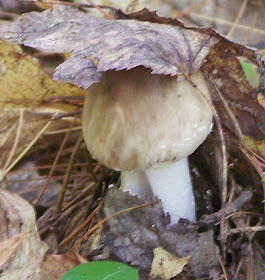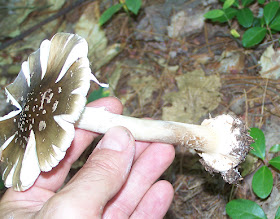One of the most memorable culinary experiences I’ve had was a wild mushroom soup prepared and served at the Mountain Top Inn in Vermont. My wife and I stayed there on one of our anniversaries many years ago. I don’t have the recipe or remember the chef’s name, but I do remember that the soup had a rich and unique flavor quite unlike ordinary mushroom soup. Unfortunately, I don’t even know what kinds of mushrooms were used in the soup.
The forests of New England are absolutely full of mushrooms of many, many varieties. Some are edible and some will kill you dead. Others fall somewhere in between those extremes. It is not uncommon here to read about people dying of mushroom poisoning. Often it’s an entire family as someone picked the wrong kind of mushrooms and prepared a family dinner with them. Reading about these kinds of events as a child left me with a very healthy and persistent respect for wild mushrooms. If you’re not 100 percent sure what it is, don’t ever eat it.
Not ever having enough confidence to be 100% sure of a mushroom’s identity, I’ve never picked or prepared wild mushrooms for eating. As a result, I have a long-running streak of more than years without ever having fallen victim to any sort of mushroom poisoning, a streak I intend to continue. The best way to be sure is to bring a qualified and experienced expert along with you to show you the ropes.
Don’t Listen to Me about Edible Mushrooms
Furthermore, I would never rely on any advice about what mushrooms will or will not kill me that I find on someone’s personal blog, no matter how authoritative they may sound. I’d strongly advise you to use that same caution, especially with regard to my blog. I am not a mushroom expert, I am not giving you enough detail to distinguish edible mushrooms from poisonous ones. Do not try this at home.
Building Mushroom Identification Skills
Having said all of that, I’ve always wanted to learn to identify edible mushrooms, but have never really sat down and tried to learn the skill. Now, however, I am in the process of trying to identify every species of plant, including fungi, lichens and other plant-like creatures (as well as every animal species) that grows or lives in my 5.25 acre yard in Southern New Hampshire. Much of my yard, over four acres by my estimate) is forested so there is a wide variety of plants, animals and mushrooms present.
Always Assume the Worst
If I am to identify all those things, I’ll certainly need to know how to identify mushrooms. That means learning all the important (and minor) characteristics of mushrooms that are used by experts to distinguish one from the other. I’ll need to know which ones have near look-alikes, which ones are easy to identify, and which ones are nearly impossible to be sure of without detailed microscopic or chemical analysis. Always err on the side of survival: if there is any possible alternative identification which is not a confirmed edible variety, assume the worst and don’t take chances.
If I can do all of those things, then I should be able to confidently identify some edible mushrooms. The first mushroom that I found and chose for identification turned out to be the Cleft-foot Amanita (Amanita brunnescens), a mushroom listed as “possibly poisonous,” but certainly related to and similar in appearance to many very poisonous varieties of mushroom. In identifying this mushrooms, I learned a few more of the key traits that I should look for, including how to take a spore print to help narrow it down.
Mushroom Propagation Experiment
I’ve also heard from talking to experienced wild mushroom gatherers this summer, that wild, edible mushrooms frequently do not recur in the same location from year to year, although they might show up again several years later in a spot where they were previously found. This seems a bit curious, but I suspect that there are either spores or rhizomes present once the mushroom has grown there, but they simply need specific weather conditions to begin growing. Many mushrooms grow among deciduous leaf litter or pine needles, which gets me thinking.
“Seeding” New Mushrooms from a Paper Spore Print
If I take a spore print of a mushroom on a piece of plain paper which is made of much the same raw materials as leaf litter… Could I simply take that spore print to a suitable area of the forested part of my yard similar to where the original was found and place that spore-covered sheet of paper under a layer of leaf-litter and get more of the same mushrooms to grow the following year? I don’t know, but I certainly intend to try. After all, if you are “seeding” a specific variety of mushroom in a very specific location and what grows matches the ID marks for the target species, you can have a pretty darn good confidence in the species and edibility of the resulting mushroom, if any indeed result at all. Furthermore, you could cultivate larger quantities in this manner to ensure a good supply in future years.
Bear in mind, I’m not talking about introducing non-native varieties, but simply helping mushroom species that already grow wild in my yard to grow in more places in my yard, assuming, of course, that I find any edible varieties here to begin with.

 . The mushroom specimen pictured here appears to be the cleft-foot amanita (Amanita brunnescens). A species listed as "possibly poisonous," but closely related (and similar in appearance) to some very seriously poisonous Amanita mushrooms. How did I get to that conclusion? Let's go through the steps.
. The mushroom specimen pictured here appears to be the cleft-foot amanita (Amanita brunnescens). A species listed as "possibly poisonous," but closely related (and similar in appearance) to some very seriously poisonous Amanita mushrooms. How did I get to that conclusion? Let's go through the steps.

